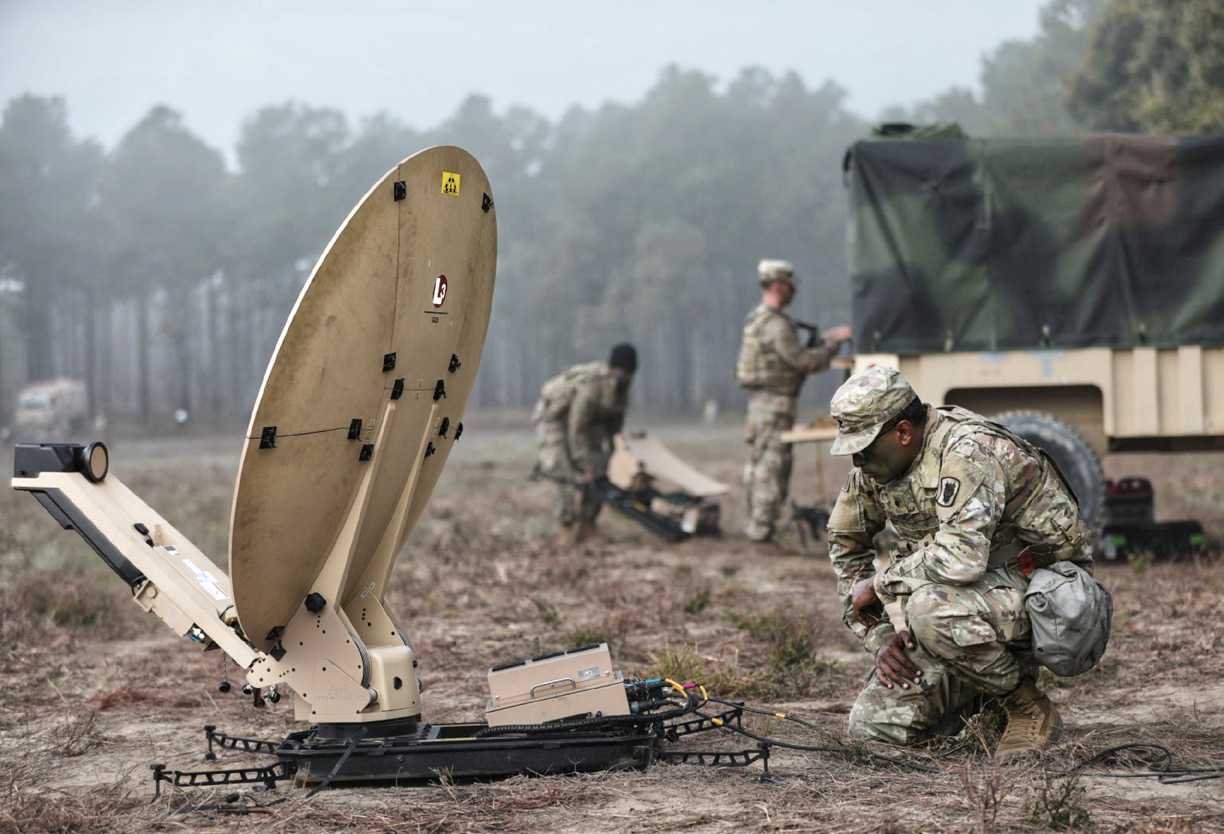The fusion of electronic warfare (EW) tactics and satellite communications stands as a critical cornerstone in modern military strategies.

The escalating reliance on cutting-edge technologies to gain strategic advantages has accentuated the intricate interplay between EW tactics and the safeguarding of satellite communication systems.
This article delves deeper into the multifaceted dimensions of EW, evolving jamming technologies, countermeasures, and the escalating role of anti-jamming technologies in fortifying satellite communications on the dynamic battlefield.
Electronic Warfare
Dynamics Jamming,
Detection and
Spoofing
EW encompasses diverse tactics, with jamming technology serving as a prominent method employed by adversaries to disrupt or interfere with desired signals.
These threats exhibit a spectrum of sophistication, ranging from overt transmission blocks to elusive and subtle interference patterns, posing significant challenges to signal integrity and reliability.
Moreover, EW maneuvers encompass signal detection, geolocation for targeting and the intricate art of signal spoofing, encompassing pivotal systems such as GPS and communication devices.
Historical
Countermeasures
and Contemporary
Technological
Advancements
Historically, countering jamming threats primarily relied upon spread spectrum technology, notably Frequency Hop Spread Spectrum (FHSS). However, contemporary advancements have propelled anti-jamming capabilities into the digital realm, primarily through the use of Direct Sequence Spread Spectrum (DSSS).
Additionally, signal excision technologies, exemplified by Communication Signal Interference Removal (CSIR™), have emerged as formidable tools in neutralizing interference without being reliant on traditional spread spectrum techniques. The amalgamation of DSSS with CSIR technology epitomizes a robust anti-jamming solution, amplifying data throughput capacities beyond the constraints of conventional FHSS methods.
Low Probability of Interception/Low Probability of Detection (LPI/LPD) mechanisms constitute pivotal countermeasures against geolocation-based jamming threats. Leveraging DSSS, these techniques effectively diminish the power spectral density of carriers to levels below discernible thresholds amidst background noise.

The integration of DSSS with CSIR technology enhances the effectiveness of LPI/LPD measures and also elevates the data transmission rates of these signals, crucial in scenarios with inherently low user data rates.
Spoofing, a highly sophisticated EW threat, necessitates intricate countermeasures. The integration of x.509 digital certificates, a cornerstone of transmission security (TRANSEC) solutions, represents a robust defense mechanism against spoofing attempts. However, in scenarios where bidirectional certificate exchanges prove unfeasible, such as broadcast signals including Position Navigation and Timing (PNT), simpler encryption methods stand as effective anti-spoofing measures for safeguarding PNT signals.
The Proliferation
of Excision
Technology and
Its Role in
Mitigating EW
Threats Dynamics
Jamming,
Detection and
Spoofing
The prowess of excision technology lies in its ability to effectively mitigate diverse forms of interference, ranging from carrier waves to intermittent and fastmoving threats, all without necessitating prior knowledge or additional hardware.
This capability assumes particular significance as adversaries increasingly employ signal intelligence (SIGINT) strategies to disrupt military and governmental spectrum use.
In the pursuit of secure and dependable communications infrastructure, the evolution of anti-jamming technologies remains instrumental in fortifying satellite transmissions across dynamic and adversarial landscapes. These advancements play a pivotal role in mitigating threats, fortifying troop safety across varied terrains — land, air and sea — and ensuring the integrity of sensitive data and SATCOM networks against hostile incursions.

The symbiotic relationship between EW strategies and the protection of satellite communications epitomizes a critical nexus in contemporary military operations. As technology continues to evolve, the perpetual arms race between EW tactics and countermeasures underscores the need for robust, adaptable and innovative approaches to fortify satellite communication systems against emerging threats in the ever-evolving battlefield environment.
www.idirectgov.com

Karl Fuchs
Karl Fuchs is the Senior Vice President of Technology at iDirect Government (iDirectGov), a U.S. corporation that is a trusted partner of the U.S. government and has been for more than 18 years. All its employees are U.S. citizens, with a third being U.S. military veterans and more than 60% holding U.S security clearances. Fuchs leads iDirectGov’s team of federal systems engineers and serves as chief architect for new product integration and specialized technology including transmission security (TRANSEC), Communication Signal Interference Removal (CSIR™) anti-jam technology and Open Antenna Modem Interface Protocol (OpenAMIP). All Defensegrade products sold by iDirectGov are designed, developed, assembled, programmed and verified within the United States. Fuchs has more than 20 years of experience in the areas of technology and the federal government and is a Senior Contributor to MilsatMagazine: kfuchs@idirectgov.com.

